by Dorothea
Burstyn
(click on photos to enlarge image)
TOASTING FORKS
The majority of toasting forks were made of iron,
brass or simple wire, this study only concerns
itself with the use, styles and history of the
silver toasting fork. It has been suggested that the
silver toasting fork was intended to be used in the
dining room "to give employment to amateur cooks"(note
1) or was handled "by those who preferred
to do their own toasting before the dining room or
sitting room fire"(note
2). These quotes seem to suggest that the
choice of material - silver - was determined by the
location in which this implement was to be used. In
contrast, modern thought categorizes the silver
toasting fork as kitchenware
(note 3).
The incentive to choose silver for so many medical
and kitchenware utensils must be found in the
hygienic properties of silver. Besides until the
mid-nineteenth century (and possibly even later),
people who could afford silver toasting forks had
servants who did all the food preparation.
|
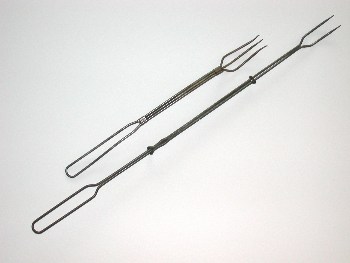 |
|
American kitchen toasting forks, made from
wire
|
Apart from the examples of toasting forks in my own
collection, which triggered my interest in the first place, I
wanted to make a survey of existing toasting forks. Looking
through auction house catalogues brought a few results, but a
search through the published catalogues of American museums
proved futile. The biggest collection of toasting forks (eleven
pieces) is in the Victoria and Albert Museum, London. If one
wanted to enter into any meaningful discussion of style and its
evolution, a visit seemed imperative
(note 4). Most
of the V & A collection, which spans from 1669 to 1889, was
assembled with an eye for quality and the unusual by Dr. Louis
Clarke, a member of the Society of Antiquarians and curator of
the Fitzwilliam Museum
(note 5).The earliest example in the V & A, dated 1669,
as well as a Charles II silver-mounted toasting fork
(note 6)
feature elongated two-pronged forks with a backward hook,
devised so that slices of bread and cheese or meat could be
toasted together.
 |
Two Charles II silver-mounted toasting forks,
ca. 1670,
Photo courtesy of Christie's South Kensington,
London, September 2001
|
Another Charles II fork has four prongs, more
suitable for toasting teacakes or apples. Both of
these Charles II examples are marked with DL, a
trefoil above and a mullet below, the mark of a
maker who might have specialized in these implements,
as he is also recorded in Jackson, revised, to have
made a "long toasting fork," 1672-73
(note 7).
Both examples have tapered handles with central
silver ferrules, the terminals furnished with reeded
ball finials and suspension rings.
|
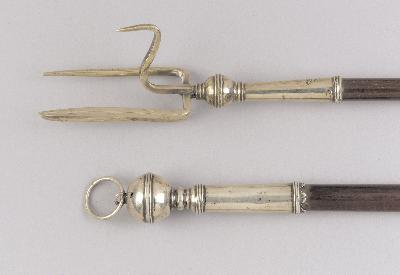 |
|
Detail of Charles II silver toasting fork
|
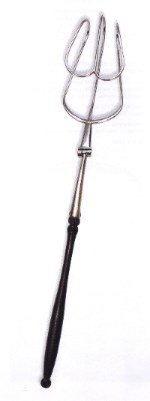 |
Another toasting fork, dating to about 1680
(note 8)
and marked with the maker's mark of F.G over a star
in a shaped shield, features the same arrangement of
tapered handle, central ferrule and ball shaped
terminal with suspension ring, but is equipped with
a C-shaped, two-pronged fork with a pivoted
stirrup-shaped toast-holder. This fork combines the
toasting fork and a related utensil, the toaster.
The toaster has an arrangement of tapered back hooks
forming a basket-shaped device or rack in which a
sandwich can be inserted. A charming example is in
the V & A, dating to ca. 1690 and marked with the
maker's mark of Ro crowned. The toast holder
consists of two hooks, the ends of which are formed
as eagles' heads
(note 9).
The toaster with variations of basket and hook
arrangements is an enduring style. Examples found in
1709 (note
10) and Exeter, 1816 are on record. Another
more sophisticated specimen was made by Thomas
Whipham, London, 1749, the wirework basket being
attached to a short shaft via a hinge
(note 11).
T. Phipps and E. Robinson of London made a variety
of toasting forks and toasters
(note 12).
The pièce de resistance is an example dating to
1797: ingenious, yet simple, the triple-hooked toast
holder and a three-pronged fork are both hinged to a
tapering socket, the two hinges being arranged in a
way to allow either the toast holder or the fork to
be used. If the basket is used, the fork can be
folded parallel to the handle, a space in the hinge
of the basket holding it in place
(note 13).
|
George III silver toaster,
Exeter 1816, apparently
no master mark
|
|
From the 1790s on ingenuity was the name of the
game. A successful silversmith, Sir Edward Thomason,
reminisces in his Memoirs During Half a Century
about his inventions: "In 1809 I invented the
sliding toasting fork, some with one, two, or three
slides, within a handsome japanned handle, common
now in all the shops. I also invented one that by
the action of drawing the slide, the same movement
raised a shield from off the prongs, and upon
shutting up again of the slides this action moved
the shield over the prongs. I also invented a third
kind, which was that the three prongs collapsed
together, which, on the shutting up of the slides of
the fork, drew the same into the mouth of a snake,
the head of a silver snake being attached to one end
of the outer slide or handle. The above were made in
silver, gilt, plated, and brass; and large
quantities were sold even by me; but, as I did not
protect this invention by patent, thousands were
made and sold by other manufacturers"
(note 14).
An example of his wonderful toasting fork with
collapsible prongs, made of various metals with a
black japanned handle and a gold-plated snake head,
is in the collection of the Birmingham Assay Office.
Patented or not, the sliding - or better telescopic
- toasting fork was made much earlier than 1809 by
other makers, as there is an example marked with
maker's mark TID, dating to London, 1804, in my
collection and yet another one, made by the same
maker, 1807, in the former Albert collection
(note 15).
|
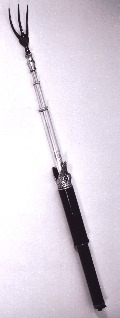 |
|
Toasting fork by E. Thomason.
Photo courtesy of
Birmingham Assay Office
|
 |
Telescopic toasting fork, London 1804, master
TID, with shagreen handle
|
A slender four-part extending toasting fork is hallmarked
for London 1809 and made by George Collins.
 |
Telescopic toasting fork from Weeks Museum,
London 1809, by George Collins, fully extended.
Photo courtesy "The Finial" - Daniel Bexfield
Antiques, London Mayfair.
|
 |
Detail of telescopic toasting fork, from
Weeks Museum, closed
|
It is inscribed around the outer collar with B[ough]t at
Week's R[oyal Mechanical] Museum, Tichbourne Stt, 1138.
Curiously a parasol with a telescopic handle and an inscription
identical to the one on the toasting fork (except for the number
1013) surfaced in the estate of a prominent English dealer. It
turns out the handles on both, the toasting fork and parasol,
are identical in length and were made by the same maker, but the
parasol handle was assayed in 1802. As Mr. Weeks started his
commercial life as an umbrella manufacturer, the question arises
whether both items started out as parasols or toasting forks
(note 16).
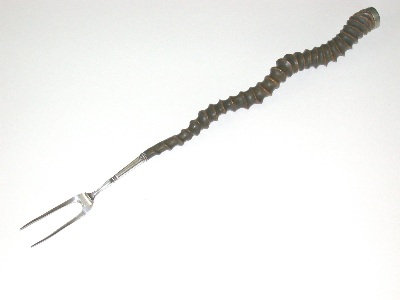 |
Telescopic toasting forks, supposedly invented
for traveling, are relatively short and measure
closed from 9 to 12 inches. They may have sterling,
Sheffield plate or japanned handles. The majority of
toasting forks are equipped with wooden handles.
Ebony or hard fruitwoods are most commonly chosen,
measuring 36 to 39 ½ inches; black buckhorn is seen
on Anglo-Indian toasting forks
(note 17).
I came across two all silver toasting forks, both
having handles very similar to Warwick cruet stands.
One is in the V & A (M.1674-1944) and is thought to
be a fake or a concoction of parts put together from
various sources. In any case, due to silver being an
excellent conductor, an all-silver toasting fork
without heat-spacers seems a very impractical
instrument.
|
Anglo-Indian toasting fork
|
|
Given the great variety of types, styles and patterns of
American flatware, it is surprising that not more American
silver toasting forks surfaced in the survey. Up to now I found
only two examples, one made by Gorham in 1889.
 |
Special order toasting fork, Gorham 1889
|
 |
Detail of the Gorham toasting form, note the
swivel mechanism
|
The costing record
(note 18)
calls it "1357 Toast Fork" and indicates that it was
a special order made December 4, 1889 for the
Providence, Rhode Island, retail jeweler Tilden &
Thurber. The three-pronged fork is attached via a
swivel to an extension rod that slides in and out of
the wooden handle and is controlled by a silver
screw on top of the socket. It measures 22 inches
closed and can be extended to a length of 36 inches.
The handle is fruitwood with a lovely acorn finial.
The central ferrule is divided into two parts by a
beaded band, the lower section being engraved with
M.P.B.H. Nov. 16th, 1889. That the inscription
features four initials (presumably his and hers),
plus the fact that the fork is engraved with a date
earlier than it was actually produced, makes one
suspect that it was given as a wedding present as it
was an accepted custom to give wedding presents up
to one year after the joyous event. The other
American toasting fork was seen on Ebay; it is also
made by Gorham, dating to the 1890s, featuring an
ivory handle, two elaborately shaped wires form flat
grips to hold the toast.
|
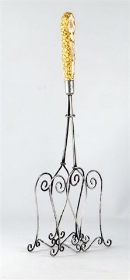 |
|
Silver toaster by Gorham, ca.
1890
|
As described earlier, two- and four-pronged forks were made,
but the most enduring form over the centuries by far is the
three-pronged type.
 |
Toasting fork and bread fork ny T. Bradbury &
Sons, Sheffield 1918 and 1894
|
And when a new serving implement for bread was introduced in
the 1880s, it was the three pronged style that prevailed.
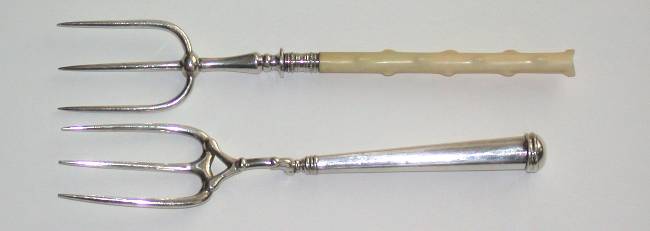 |
Two bread forks, Sheffield 1898 and London
1897
|
It is interesting to note that James Dixon & Sons made an
electroplated nickel silver combined bread and toasting fork:
the short version to be used for bread, the utensil is equipped
with a separate extension rod which transforms it to a toasting
fork (note 19).
We know from old records that toasting forks existed as early as
the 1550s in noble English households
(note 20).
Astounding is that - probably English-made - silver toasting
forks were to be found in America as early as the mid-17th
century (note 21).
Toasting forks were part of the equipment affluent students took
to university; Lloyd Evans received one as a present from his
mother in 1669 (note
22) and John Courtenay donated his toaster, made 1706,
to his alma mater (note
23). Given that dinner was served quite late at the
universities, a cheese toast or a roasted apple might have been
welcome treats in between meals. As mentioned before, telescopic
toasting forks were popular on travels. Recounting her early
travels to the continent, Lady Caroline Capel called her
toasting fork a treasure which made many a bit of sour bread
more digestable (note
24).
The legendary collector, tastemaker and bon vivant William
Beckford owned three toasting forks that he took with him on his
various travels (note
25). An epitome of sheer luxury and elegance is his
unique gold toasting fork. Bought shortly before his journey to
Portugal, it is dated 1793, measures 38 3/4 inches in length and
features exquisite floral chasing on the baluster stem and three
fluted prongs (Fig. 15 and Fig. 16). The elongated ebony handle
is capped in gold and furnished with a gold ring. As usual the
combination of impeccable provenance, beauty of design, precious
material and extreme rarity is rewarded in the marketplace; this
piece was sold at Sotheby’s in April 1998 for the remarkable sum
of $134,500 (note 26).
 |
William Beckford’s gold toasting fork, London
1793.
Photo courtesy of Sotheby’s New York, April 1998
|
 |
Detail of the Beckford gold toasting fork
|
Dorothea Burstyn is the Editor of the Silver Society
of Canada Journal
and Administrator of SSC website
http://www.silversocietyofcanada.ca
- 2010 -
|
|
|
 ASSOCIATION OF SMALL COLLECTORS OF ANTIQUE SILVER
ASSOCIATION OF SMALL COLLECTORS OF ANTIQUE SILVER













